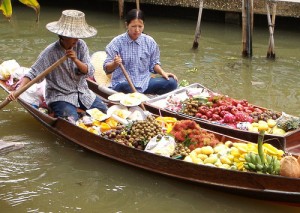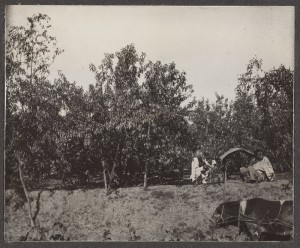- Making French cheese in the Himalayas.
- The latest on how to build your perfect dog.
- “The scientists are putting the all the trees which must be saved into a data bank.” Clever scientists.
- Polyploidization so, so much more than merely the sum of genomes.
- “The expected direct reduction in total agricultural production in the absence of animal pollination ranged from 3 to 8%…” Thank goodness for Operation Pollinator, eh?
Nibbles: Bees, Weeds, Free fruit, Flour, Bombus
- Colony collapse disorder: where are we now?
- Weedkiller diversity essential to maintain weed susceptibility.
- Eat the streets.
- Ancient Grains Flour Blend. A baker asks: Whatever next?
- Bumblebee beauty.
Agricultural biodiversity and its perception, then and now
Hanging around the library today, I happened to pick up the March 2009 issue of Economic Botany, and was rewarded with a couple of really interesting papers on people’s perceptions of agrobiodiversity, and how it can be different to what you might think.
The first paper looked at knowledge of apple diversity among cider-makers in the United Kingdom and the United States. 1 The working hypothesis was that cider makers with a long history in the business would know more apple variety names that comparative neophytes. The results of semi-structured interviews with about 30 informants in Washington State, England, Wales and Northern Ireland suggested that this was not in fact the case. Experienced cider makers do indeed know more apple varieties, but not necessarily by name. They keep track of diversity in other ways, by taste, smell and ecology. The art of cider making lies in the blending, so the maker needs to know what each apple tastes like, on its own and in combination.
Cider makers who have a sense of rootedness to their land often know intricate details about trees in their orchards. They may know the rate at which they bloom, which trees do better in which conditions, or what the sugar levels of fruits will be on a given year. With all this knowledge, why would names have significance?
This would seem to contradict the findings of other studies which suggested that there’s a high degree of correspondence between number of local names and genetic diversity. Names might be lost, but the knowledge of diversity — and, at least for now, the diversity itself — is still there.
The second paper looks at how diversity in grapevines was perceived in the past. 2 Its subject is the Baroque altarpieces in Galicia, and in particular the twisted columns known as Solomonic. These often feature grapevine leaves, and the authors measured various morphometric variables on these representations, as well as on the real leaves of numerous varieties maintained in a local genebank. You know the kind of thing. The angle between this and that vein. The depth of the nth lobe.
They found that the representations were often very faithful, and could be used to identify specific local varieties. With a more extensive dataset (that is, more characters, and more altarpieces), it might be possible to reconstruct the history of cultivation of various now rare or extinct local cultivars. Another example of the imaginative sources of data people are looking at to get a handle on genetic erosion.
Obligatory photos of agricultural biodiversity in Thai floating market go online to stifled yawns
I’m very ignorant about SE Asia, so I assumed that the famous (or infamous) “floating market of Bangkok” would be in Bangkok, rather than over 100km away. I also didn’t really expect it to be quite the tourist trap it is. Oh well. But they do sell a remarkable variety of fruits, vegetables and other assorted agrobiodiversity there. Go to my Flickr page and leave as many identifications as you can.

Frank and the giant peach
While Luigi was getting excited about giant parsley, frequent tipster Dirk Enneking sent word of giant peaches, a much tastier quarry. The great plant explorer Frank Nicholas Meyer traveled widely in the east and sent many collections back to the USDA, his employer. 3 He wrote a wonderful account of his Agricultural Explorations in the Fruit and Nut Orchards of China, published in March 1911 (and, gloriously, available thanks to Google.) Meyer describes the diversity of Chinese peaches, singling one out for special praise.
The best of them all is the “Fei Tau,” or Fei peach, Feitcheng being the name of the village where the orchards are located. These peaches grow to a large size, often weighing over 1 lb apiece, and are of a soft, pale-yellowish colour externally, with a slight blush on one side. The meat is white except near the stone, where it is slightly red. The fruit is a clingstone, with a very large, pointed stone. The skin is very downy. The fruit ripens in the early and middle part of October and has an excellent flavor, being sweet and aromatic. It possesses extraordinary keeping and shipping qualities, keeping until February if wrapped in soft tissue paper. Its shipping qualities are such that it is carried in baskets, slung on poles across the shoulders of coolies, from Feitcheng to Peking, a journey of eight days on foot. So famous is this peach, that it is sent every year as a tribute or present to the imperial court at Peking; and even right on the spot where this fruit grows the most perfect specimens retail at from 10 to 15 cents in Mexican money, a price which is about two-thirds of the average daily wages of the Chinese field laborer.
I want to try one of those! How many of the varieties Meyer mentioned are still available in China?

Whether you think Meyer’s comment says more about low wages than high prices, the fact impressed Meyer enough to note it. But why were they using “Mexican money”? Meyer describes lots more peach diversity.
Some of these peaches are blood red and when cut through look more like a beet root than anything else. One variety in Shansi is even called the “Rho Tau,” or beef peach, so much does it resemble meat.
He also mentions flat peaches, red and white, which by the sound of it resemble the ephemeral “Saturn” peaches that briefly show up in the fruit-shops of Rome and can perfume a large room with their scent.
Meyer points out that the Chinese genetic diversity had, and in 1911 still has, a lot to offer growers in the US, and that, after all, was his job, to plunder the resources of another sovereign state and bring them back to improve US agriculture. But has anyone calculated the contribution of Chinese peaches like the ones Meyer noted to peaches in the US and elsewhere? It would be a fascinating and tasty case study.